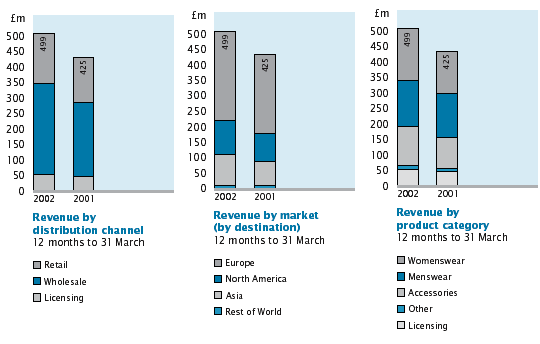|
|
During the year, Burberry grew revenue by 18%
and operating profit by 30%. This was a strong performance, particularly
in light of the difficult macro-economic environment, which adversely
impacted many luxury goods companies.
Operating margin increased by 1.7% to 18.1%, driven by gross
margin improvement, a first time contribution from Asia (£4m) and growth
in licensing revenue from Japan. During the year, Burberry continued to
invest in the development of its retail network and its infrastructure.
 |
Burberry |
|
|
|
 |
 |
 |
 |
 |
 |
 |
 |
|
2002 |
2001 |
|
|
Underlying |
 |
12 months to 31 March |
£m |
£m |
|
Change |
change* |
 |
 |
 |
 |
 |
 |
 |
 |
 |
 |
 |
 |
 |
 |
 |
Sales |
499 |
425 |
|
18% |
10% |
| |
Operating profit |
90.3 |
69.5 |
|
30% |
21% |
 |
Operating margin |
18.1% |
16.4% |
|
|
 |
 |
 |
 |
 |
 |
 |
 |
 |
* at constant exchange
rates, excluding the operations of Burberry’s distributors based
in Hong Kong, Singapore and Australia which were acquired on 1 January
2002 and adjusted for the pre-acquisition period for Spain, which
was acquired in July 2000. |
An analysis of revenue by product category, by distribution channel and
by region is shown below.
Product
Each of Burberry’s core product categories continued to grow during the
year. With an increase of 28%, accessories led the group, contributing
25% of total revenue in the year. An expanded product range and wider
distribution led to 23% growth in womenswear, which accounted for 33%
of total revenue. Menswear sales also rose and now represent 30% of revenue.
Retail
Sales in Burberry’s directly-operated retail stores were up 10% in total.
During the year, it successfully opened six new stores and concessions
in markets as diverse as Beverly Hills, California, SoHo in New York City
and suburban Westchester County, New York. Including 7 stores and concessions
acquired as part of the Asian transaction, Burberry had 69 retail stores,
including 10 concessions in prestige department stores, at 31 March 2002.
Eleven new and replacement stores are scheduled to open in the current
financial year. These include flagship stores in New York City, Knightsbridge
and Barcelona.
Wholesale
Sales to wholesale customers grew by 21%, with growth in all regions.
The strength and appeal of the Burberry brand, the widening product range
especially in accessories, coupled with the rollout of the Bond Street
corner concept, has encouraged prestige retailers to continue to allocate
prime space to Burberry products.
As previously announced, with the Autumn/ Winter 2002 wholesale order
book now largely complete, sales for this season are expected to be broadly
in line with those of a year ago. Demand from travel-related retailers
has been influenced by the fact that the volume of international travel
is recovering only slowly. Orders from Spain are also being affected as
Burberry repositions in that market. Offsetting these factors, however,
is continued strong growth in the United States where Burberry, it is
believed, is still under-represented.
Licensing revenue
Licensing revenue in 2002 grew by 17%, mainly because of the brand’s strength
in Japan, its largest market. This growth at retail sales value has only
a modest impact on the total reported revenue for Burberry because, under
its licensing arrangements, Burberry receives a small percentage of the
value of the products sold. Burberry’s profit benefited substantially
in 2002 from both the volume growth in Japan and the renewed licensing
arrangements, under which the royalty rate increases each year up to 2006.
The beneficial impact of this increase in 2003 is expected to be offset
by the weakness of the yen relative to 2002 levels.
Asia outside Japan
With effect from 1 January 2002, Burberry completed the acquisition of
the operations of its distributors based in Hong Kong, Singapore and Australia.
Having contributed £4m to profits in the year to March 2002, it is expected
to add incremental operating profit of £5m to £10m in the year to March
2003.
In March 2002, Burberry signed an agreement to acquire its Korean distribution
business, which primarily operates 45 retail concessions in prestige department
stores. Burberry expects to complete this acquisition in early July 2002.
The deal is expected to add approximately £5m to operating profit in its
first twelve months.
With these transactions, which are immediately earnings enhancing, Burberry
has gained direct control in these important markets. It now has direct
control of the distribution of its core products in all key markets outside
Japan.

|

